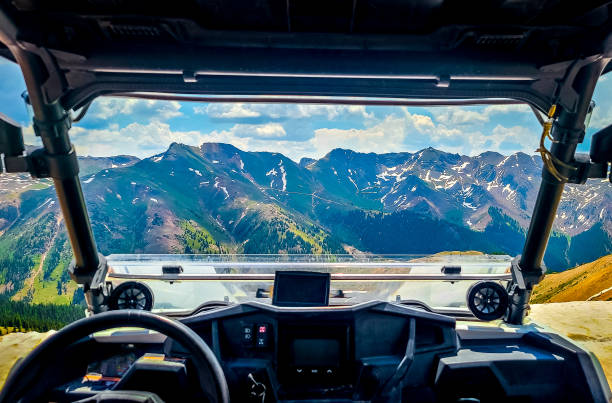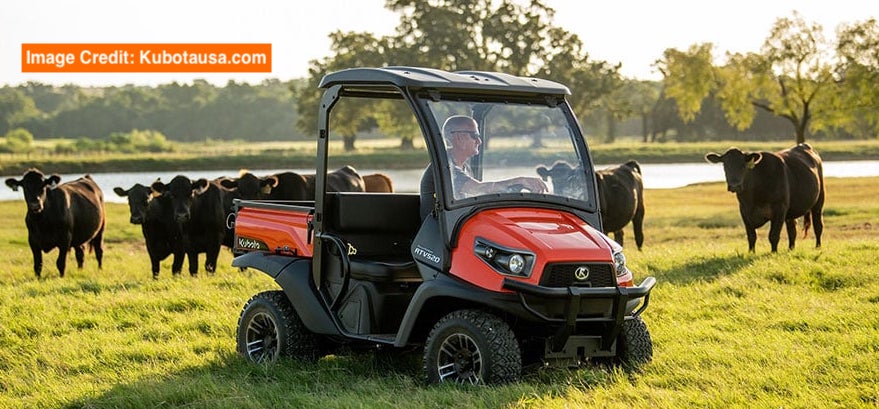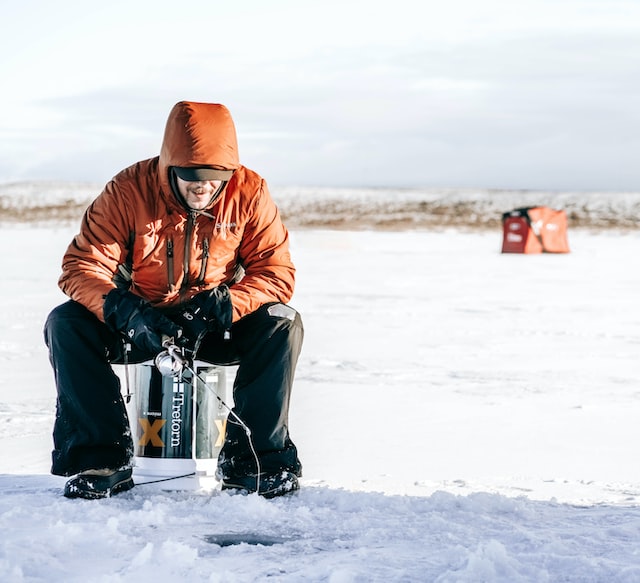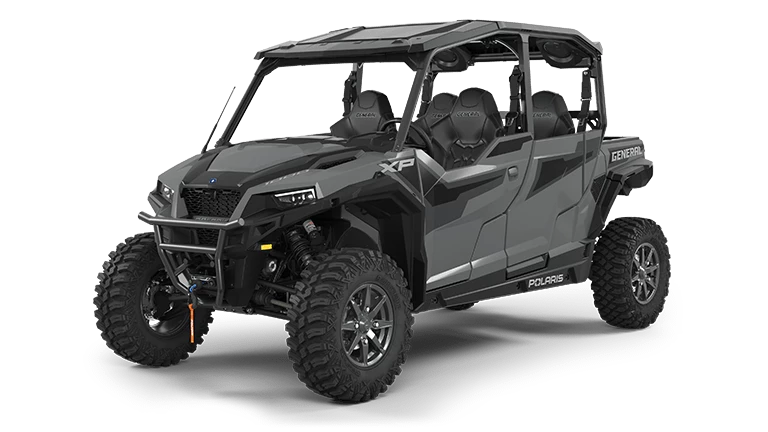As an Amazon Associate I may earn a commission from qualifying purchases at no additional cost to you.
When renting ATVs and Side by Sides, ensuring these vehicles are in good condition is crucial for safety and reliability on the trails.
While ATVs are single-rider vehicles designed for maneuverability, Side by Sides accommodate more passengers and come with more safety features.
Evaluating these vehicles involves examining the tires, brakes, and overall structural integrity to ensure they meet safety standards before heading out on an adventure.

A thorough inspection involves checking engine performance, fluid levels, and ensuring that all lights and signals work properly.
For ATVs, riders should pay close attention to the handlebars and suspension, which can affect control and comfort. For Side by Sides, it’s important to inspect the roll cage, seat belts, and doors to ensure they function correctly and provide adequate protection in case of an accident.
Understanding the differences between ATVs and Side by Sides can lead to a safer and more enjoyable riding experience. Each vehicle type presents unique inspection requirements. Riders must take special care to inspect the features specific to each, enhancing both safety and performance.
Understanding ATVs and Side by Sides
All-terrain vehicles (ATVs) and Side by Sides (SXS) offer distinct experiences and uses for adventure enthusiasts. Their design, features, and functionality cater to various needs, from recreational pursuits to utility tasks.
Key elements to consider include their definitions, inspection purposes, and ownership considerations.
Defining ATVs and Side by Sides
ATVs, or All-Terrain Vehicles, are compact, single-seat or dual-seat machines designed for off-road use. These vehicles typically have handlebars for steering and four wheels, providing stability and ease of control. They are known for their nimble handling and versatility on rugged terrains.
In contrast, Side by Sides, also known as SXS or UTVs (Utility Task Vehicles), are larger and often feature an enclosed cabin with a steering wheel. They can seat two to six passengers side-by-side, thus their name. SXS are favored for providing more passenger comfort and storage space, making them ideal for work and play.
The Purpose of Inspection
Thorough inspection of both ATVs and Side by Sides is crucial to ensure safety and functionality. It involves checking essential components, such as tires, brakes, and safety equipment. Inspectors look for signs of wear and damage to critical parts and verify that electrical systems and controls operate correctly.
For rental ATVs, ensuring that they are in optimal condition is particularly vital, as it reduces the risk of accidents and maintenances issues for users. With Side by Sides, checking the condition of seatbelts, roll cages, and lighting systems is crucial given their role in tagging along multiple passengers. Proper inspections help maintain high performance and safety standards.
Ownership Considerations
Owning an off-road vehicle, whether an ATV or a Side by Side, involves commitments beyond the initial purchase. Maintenance, storage, and adherence to local regulations are key aspects of ownership.
ATV owners often benefit from lower maintenance costs due to the vehicle’s smaller size and simpler mechanics.
Side by Side owners may face higher costs related to upkeep and insurance, given the vehicles’ larger engines and complexity. Prospective buyers should consider factors such as intended use, carrying capacity, and terrain type when deciding which vehicle best suits their needs. Both ATVs and Side by Sides offer unique benefits, and careful planning ensures a satisfying ownership experience.
Inspecting Rental ATVs
When evaluating rental ATVs, it’s crucial to focus on several areas to ensure safety and functionality. Initial inspections should assess physical condition, mechanical integrity, and proper safety gear.
Initial Visual Assessment
Start with a walk-around inspection, checking for any visible damage to the body and frame. Scratches, dents, or rust can be indicators of previous accidents or poor maintenance.
Examine the tires for proper tread and wear patterns; uneven wear might suggest alignment issues.
Look for any leaks under the ATV. Fluid leaks could indicate problems with brakes, engine, or transmission. Inspect lights and reflectors to ensure they are intact and functioning, as these are vital for visibility and safety.
Mechanical Components Check
Evaluate the brakes by squeezing the lever and feeling for firm resistance. The throttle should move smoothly and return to its original position promptly when released.
Listen for unusual noises when operating the engine; rattling or whining could signal mechanical issues.
Check the suspension by pressing down on the ATV; it should absorb the shock evenly without bouncing excessively. Ensure all cables and hoses are free from cracks and are securely connected. Properly lubricated control cables are crucial for responsive handling.
Safety Gear and Accessories
Rental ATVs should come equipped with essential gear.
Ensure that helmets provided are certified and fit securely without discomfort. Goggles should be clear, scratch-free, and provide a wide field of vision, protecting against debris and sun glare.
Check that rental agreements include any additional safety gear such as gloves and protective clothing. Accessories like cargo racks should be inspected for stability and weight limits. Confirm that all safety features meet local safety standards before proceeding with rental.
Evaluating Side by Side Condition
Inspecting the condition of a Side by Side vehicle involves paying close attention to its physical integrity, engine performance, and electronic functions. Each component plays a crucial role in ensuring a reliable and safe ride.
Body and Structure Inspection
Start with a thorough visual inspection. Check the frame for cracks, rust, or bends. Look at the suspension and axles for any signs of wear or damage. Inspect the body panels and roll cage, ensuring they are free of dents or signs of previous repairs.
Pay special attention to the tires—examine tread depth and look for cracks or bubbles. Suspension components should be evenly seated and show no oil leaks. It’s important to note any missing or loose bolts, especially near safety-critical areas like seat mounts and harnesses.
Engine and Drivetrain Evaluation
Begin with a visual check of the engine for oil leaks or loose cables. Verify the engine oil level and its condition; it should be clean without metal shavings or a burnt smell.
Listen for unusual noises when starting the engine, such as knocking or excessive rattling.
Inspect the drivetrain, including the CV joints and drive shafts, for any leakage or unusual wear. Examine the transmission fluid, if accessible. Low or dirty fluids could signal poor maintenance. A test drive is crucial: evaluate acceleration, gear shifting, and braking.
Electronics and Features Functionality
Electrical systems are vital. Test the functionality of all lights—headlights, brake lights, and turn signals. Examine the condition of the battery and connections; clean and corrosion-free terminals are a good sign of upkeep.
Check any onboard digital features, like the dashboard display, for accuracy and responsiveness. Confirm that safety features such as seat belt sensors and door alarms work properly. Electronic winches should be inspected for full functionality, ensuring they extend and retract smoothly.
Every component should perform as expected, reflecting diligent maintenance by previous owners.
Maintenance and Upkeep

When evaluating rental ATVs and Side by Sides, understanding their maintenance and upkeep is crucial. Regular maintenance ensures longevity and reduces the risk of malfunctions during use. Long-term care and proper storage prevent damage and preserve vehicle performance over time.
Routine Maintenance Schedule
ATVs and Side by Sides require routine checks to maintain peak performance.
Change the oil regularly, typically every 50 hours of use or every six months. Inspect the air filter monthly and clean or replace it as needed. Proper tire inflation is essential; check monthly and adjust to the manufacturer’s specifications.
Brake inspections are also necessary. Examine the brake pads and rotors every three months. Evaluate the fluid levels, particularly brake and coolant, ensuring they are at the recommended levels. Adhering to these routine checks enhances reliability and safety for users.
Long-Term Care and Storage
Long-term care involves strategic storage practices.
Store the vehicle in a dry, covered area to protect it from the elements, minimizing rust and damage. Disconnect the battery if the vehicle will remain unused for extended periods, preventing battery drain.
Fuel stabilizer should be added to the tank if storing the vehicle for more than 30 days. Ensure the tank is full to avoid condensation. Moving parts such as chains and levers should be lubricated to prevent seizing. These steps protect the vehicle during storage and help maintain its value and functionality.
Insurance and Liability
Insurance and liability are crucial factors in managing risks when renting ATVs or Side by Sides. Appropriate coverage can protect against unforeseen accidents and injuries, while understanding liability helps clarify responsibilities.
Insurance Coverage for ATVs
Insurance for rental ATVs often involves specific coverages designed to protect both renter and owner.
Collision coverage addresses damages to the vehicle resulting from accidents. If an ATV is stolen or vandalized, comprehensive coverage might cover the costs.
Renters should verify if personal injury protection is included, covering medical expenses in case of an accident.
Many rental companies offer third-party liability insurance. This covers damages or injuries to others involved in an accident caused by the ATV renter. Renters might need to purchase additional supplemental insurance to cover gaps in coverage.
Reviewing the rental agreement thoroughly can prevent misunderstandings regarding policy limits and deductibles.
Understanding Accident Liability
Accident liability involves the legal responsibility for damages or injuries resulting from ATV use.
Renters may be held liable if negligent actions lead to an accident. Liability waivers often release rental companies from some responsibilities, transferring liability to the renter.
In some cases, joint liability can arise, involving multiple parties responsible for an accident. Knowing the local laws regarding ATV use can influence liability outcomes after an accident. Clear communication with rental companies regarding the scope of liability ensures better preparedness.
Renters are advised to confirm that their personal insurance policy extends to ATV rentals, as some standard policies may not cover recreational vehicles. Understanding and clarifying these points before renting can minimize risks and provide peace of mind.
Additional Considerations
When evaluating rental ATVs and checking Side by Side (SxS) conditions, several factors can influence the decision beyond mere inspections.
Selecting the appropriate vehicle based on personal and situational needs, considering cost factors, and exploring various financing options are critical in making an informed decision.
Choosing the Right Vehicle for Your Needs
Matching vehicle features to your specific requirements is essential. Terrain plays a key role; ATVs are great for solo rides on narrow trails, while SxS vehicles provide enhanced stability suitable for rough terrains and hauling gear.
Passenger capacity is another consideration—ATVs mostly accommodate one to two riders, whereas SxS can handle more passengers comfortably.
Another aspect is load capacity. Those needing to transport equipment will benefit from the superior carrying capacity of Side by Sides. Lastly, think about your technology requirements. Advanced models may offer GPS, digital displays, and improved suspension systems, enhancing the overall experience.
Budgeting for Your ATV or Side by Side
Establishing a budget is crucial before choosing between an ATV or SxS. Cost varies widely with brand, model, and features. An average ATV might range from $5,000 to $10,000, while SxS models could range from $7,000 to $20,000 or more.
Creating a detailed list of must-have features will help in aligning with financial constraints.
Maintenance should also be factored into your budget. Regular upkeep, such as oil changes, brake checks, and tire replacements, ensures the vehicle remains safe and functional. Setting aside funds in advance for these expenses can prevent surprises down the line.
Exploring Financing Options
Financing can make acquiring an ATV or SxS more accessible. Loans through banks or credit unions offer competitive rates, though they require a good credit score.
Dealerships frequently offer financing packages that might include incentives like reduced interest rates or extended payment plans.
Leasing is another potential option, providing the benefit of experiencing newer models without the long-term commitment.
Comparing different financing avenues allows buyers to choose a plan that suits their financial situation best, potentially making their desired vehicle more affordable.
Safety and Compliance

Ensuring the safety and compliance of rental ATVs and Side by Sides involves meeting safety standards and adhering to relevant regulations. Understanding both federal and state level requirements is crucial for operators and renters alike.
Adhering to Safety Standards
ATVs and Side by Sides must comply with safety standards to ensure rider safety. These standards often include proper braking systems, seatbelts, and headlights. Operators should inspect these features regularly.
Riders should also wear helmets and protective gear, as outlined by industry guidelines.
Regular maintenance checks are essential. Attention should be paid to tire pressure, brake function, and fluid levels. Properly functioning safety features can prevent accidents. Following the manufacturer’s maintenance schedule helps in adhering to safety standards.
Understanding Federal and State Regulations
Federal and state regulations govern the operation of rental ATVs and Side by Sides. Federal Motor Vehicle Safety Standards may apply, especially for Side by Sides, affecting features like lighting and emissions. Rental operators must stay informed about these requirements.
State regulations can vary significantly. Some states have specific state park access rules. This includes limitations on ATV engine size or required permits. Operators should provide riders with information on local regulations. This ensures legal compliance and enhances safety for all parties involved.
The Buying Process

Evaluating rental ATVs and Side by Side vehicles involves careful consideration of new versus used options, assessing warranty and service contracts, and ensuring a well-informed purchase decision. Each aspect is crucial to making a choice that balances cost with long-term value and reliability.
Evaluating New vs Used Options
When choosing between new and used rental ATVs or Side by Sides, several factors come into play.
New vehicles typically offer the advantage of being in pristine condition, equipped with the latest technology, and often include comprehensive safety features. Used options, on the other hand, might be more budget-friendly, allowing buyers to select higher-end models at a lower price.
Buyers should consider depreciation rates, as new ATVs and Side by Sides often depreciate faster. Additionally, inspecting maintenance history and verifying any prior damages in used models are vital steps to ensure reliability and performance over time.
Checklist for Used Purchases:
- Maintenance Records
- Previous Damage Reports
- Depreciation Considerations
Warranty and Service Contracts
Warranty and service contracts are key components in the buying process.
New vehicles often come with manufacturer warranties that cover defects and certain repairs, providing peace of mind. Used vehicles may not always have the same level of coverage, making third-party service contracts a valuable alternative.
These can shield buyers from unexpected repair costs. Potential buyers should compare the coverage terms, such as duration and parts covered, to ensure they receive sufficient protection. Highlighting any exclusions in the contract is also important to avoid later surprises.
Warranty Considerations:
- Coverage Terms
- Duration
- Exclusions
Making an Informed Purchase Decision
An informed purchase decision relies on gathering detailed information and weighing different factors.
Budget constraints, intended usage, and long-term maintenance costs all play significant roles.
Financing options should also be assessed, including interest rates and loan terms, ensuring affordability.
Buyers might also consider reliability ratings and customer reviews for additional insights.
Whether buying ATVs, Side by Sides, or contemplating a used boat, it is essential for buyers to invest time in research and ask questions during the purchasing process.
This ensures that the chosen vehicle meets their needs effectively, providing enjoyment and utility in the years to come.
Important Factors:
- Budget Constraints
- Financing Options
- Customer Reviews








